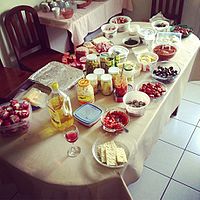Fiambre
This article includes a list of references, related reading, or external links, but its sources remain unclear because it lacks inline citations. (November 2018) |
 | |
| Type | Salad |
|---|---|
| Place of origin | Guatemala |
Fiambre is a traditional Guatemalan salad that is prepared and eaten yearly to celebrate the Day of the Dead (Spanish: Día de los Muertos) and the All Saints Day (Spanish: Día de Todos los Santos). It is served chilled and may be made with dozens of ingredients.
History
[edit]Fiambre started out from the tradition in Guatemala of taking dead family members their favorite dishes to the cemeteries for the Day of the Dead. As all different families brought food to the celebrations, they became mixed, eventually mixing them together to this all-encompassing salad. Ingredients usually include numerous sausages and cold cuts, pickled baby corn and onion, beets, pacaya flower, different cheeses, olives, chicken, and sometimes even Brussels sprouts.
This dish varies from family to family, recipes traditionally passed on to younger generations. Because of this, on the Day of the Dead, it is customary to share fiambre with other families and relatives.
Variants
[edit]
Some variants are:
- Fiambre from Antigua
- Fiambre rojo (with beets)
- Fiambre blanco (no beets)
- Fiambre desarmado (traditional of the department of Jalapa)
- Fiambre verde (no cold cuts, vegetarian)
References
[edit]- Sari Edelstein (22 October 2010). Food, Cuisine, and Cultural Competency for Culinary, Hospitality, and Nutrition Professionals. Jones & Bartlett Publishers. pp. 446–. ISBN 978-1-4496-5968-4.
- Lee Jamison (2 October 2013). Guatemalan Spanish: Speak like a Native!. Lee Jamison. pp. 85–. ISBN 978-0-615-89750-9.
